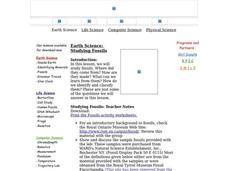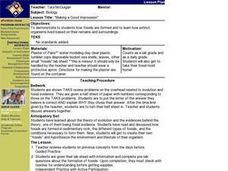Curated OER
Nebraska's Wild Weather
Students examine the weather in Nebraska. Using this information, they describe the cause and effect relationships in the environment based on these changes in weather. They write various types of poems with weather themes and share them...
Curated OER
How Does Water Cause Weathering?
Fourth graders explore the weathering process of water on rocks. They observe how water and friction from other rocks cause them to weather. Students discuss examine and discuss various rocks found on the playground, beach, etc. They...
Curated OER
Hazards: Third Grade Lesson Plans and Activities
Learners discover hazards related to volcanoes and predict the effects these hazards have on people and land. As blossoming geologists explore various volcanic eruptions, including the hazards associated with them, they create their own...
Curated OER
Lesson 1 - What Are Fossils?
Students define and research fossils. In this fossil lesson, students access teacher assigned Internet sites to examine images of fossils. They determine the definition of a fossil and find out how fossils are formed. They also define a...
Curated OER
Survey Says...
Students practice taking surveys to answer different questions about radio. In this communications lesson, students brainstorm to create questions they can ask strangers about how often they listen to their radio. Students turn the...
Discovery Education
Sonar & Echolocation
A well-designed, comprehensive, and attractive slide show supports direct instruction on how sonar and echolocation work. Contained within the slides are links to interactive websites and instructions for using apps on a mobile device to...
Curated OER
Earthquakes: Fifth Grade Lesson Plans and Activities
After learning about P waves and S waves, fifth graders view the intensity of earthquakes by examining seismographs and images of earthquake damage. Young scientists then forecasting future quakes by analyzing data about earthquakes...
Curated OER
Hazards: Fifth Grade Lesson Plans and Activities
After comparing earthquake and volcanic hazards to one another, fifth graders take a closer look at damage associated with a volcanic eruption. They then create a simulation of mudslides due to a volcanic eruption. Using different...
Curated OER
Plate Tectonics: Second Grade Lesson Plans and Activities
Second graders explore convection currents and how they relate to the movement of tectonic plates. Then, young geologists reconstruct Pangaea with a worksheet and pinpoint plate boundaries on a map using locations of earthquakes and...
Science Matters
Fault Formations
The San Andreas Fault moves about two inches a year, approximately the same rate fingernails grow—crazy! The third lesson in the series allows for hands-on exploration of various fault formations. Through the use of a Popsicle stick,...
Science Matters
Spaghetti Fault Model
Does increasing the pressure between two moving plates provide a stabilizing force or create more destruction? The hands-on lesson encourages exploration of strike-split fault models. The sixth lesson in a 20-part series asks scholars to...
Curated OER
Percents and Money
In this algebra learning exercise, students rewrite word problems using algebraic symbols. They solve for the amount of population or money over a period of time. There are 10 questions with an answer key.
Curated OER
Studying Fossils
Students study fossils. They examine samples of specific fossils--including a shark tooth, a brachiopod, and horn coral, among others. They visit corresponding websites and complete a worksheet regarding each of the fossils.
Curated OER
"Making a Good Impression"
Students are shown how fossils are formed and to learn how extinct organisms lived based on their remains and surroundings. They are shown TAKS review problems on the overhead related to evolution and fossil evidence. Students discuss...
Science Education Resource Center at Carleton College
Serc: Rock Types Lab
A well-designed lesson on rocks where students first learn about how the three categories of rocks form (sedimentary, igneous, and metamorphic), then must examine the features of different rock samples, and determine which category each...
















